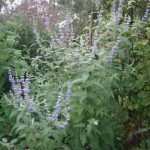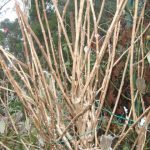Salvia cuspidata subsp. gilliesii: A tall erect Salvia to 2mH from Bolivia for a sunny position with deep sky blue flowers.

Salvia cuspidata subsp. gilliesii: is one of the few deciduous Salvias.
Flowers: are a lovely blue with a prominent white bee line down the centre from the throat down to the bottom lobe. The hood is is a softer blue grey, slightly furry, with the tip being very blue.
Not only is the bottom lobe flared out, looking like two separate lobes, but the two side lobes are in equal proportions.
The calyx: is small and blunt, the purple / grey colour on the exposed side accentuates the pale blue of the tube.
Most of the flowers are in whorls around the grey / green stems, all arranged in an open panicle.
These appear in spring through the summer months until autumn. With the prominent white bee line, no wonder the birds, bees and insects enjoy trying to get the nectar from these flowers.
Leaves: are a mid green with a blue hue, giving the plant a soft grey look. Leaves are cordate / lanceolate in shape, textured. A softer colour beneath with prominent veins, edges are softly serrated. Bigger leaves appear at the base, graduating to smaller leaves around the flowering stems.
Salvia cuspidata subsp. gilliesii: is an interesting plant, being one of our few deciduous Salvias. Grown in a sunny sheltered position, it produces many upright stems, giving an open shrubby appearance. Best grown in the middle of a bed or behind smaller shrubs where the beautiful blue flowers can be seen in late spring / summer. The soft sky blue colour of the flowers contrast well with soft pinks and whites within the garden.
When the leaves have dropped, cut back to about 1mH. Cut out any dead or twiggy stems and generally clean out. New growth will appear in spring. Although winter hardy, be careful of frosts in spring when the new growth is beginning to show.
Propagated easily from tip cuttings of new growth that has hardened in spring / summer or from hardwood cuttings stored in sand over winter.
Not often for sale.


